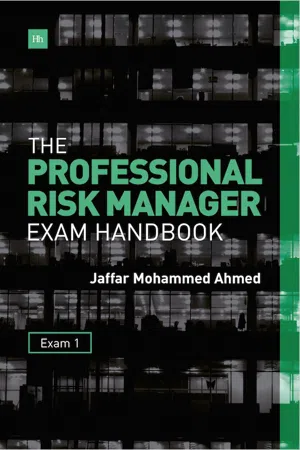
- English
- ePUB (mobile friendly)
- Available on iOS & Android
About this book
Risk management is no longer merely a passive cost-center in financial and non-financial organizations. Regulators, shareholders, executive management and investors look to risk managers for advice on risk budgeting. Since the financial crisis erupted in 2007, risk managers are expected more than before to make a thorough internal assessment of their organization's risk management frameworks and advise the board of directors and investors on their findings.Through its Professional Risk Manager (PRM) examination and qualification, the Professional Risk Managers' International Association (PRMIA) offers an outstanding tool of education for risk managers at all institutions.To be awarded the PRM designation, candidates must successfully pass four exams. The Professional Risk Manager (PRM) Exam Handbook - Exam 1 covers the Learning Outcome Statements (LOS) issued by PRMIA for Exam 1. The topics dealt with in this exam are: finance theory, financial instruments and financial markets.Due to the limited number of study manuals available for the PRM exams, candidates have previously had to rely on a wide range of resources on finance and financial instruments to learn the information they need. This approach is time-consuming and does not leave the candidate feeling confident about their readiness for the exams. The Professional Risk Manager (PRM) Exam Handbook is designed to address this problem and help PRM candidates prepare for the the PRM exams. The intention is to remove the need to refer to many different reference works and to make the obscure concepts comprehensible.The Handbook has been designed to cover everything you will need to know for PRM Exam 1. Information is presented in a clear, organized way, and demand very little previous knowledge of risk and finance. PRM candidates coming from a non-financial background should face no difficulty using this book as a reference to the intricacies of financial markets and risk management.
Frequently asked questions
- Essential is ideal for learners and professionals who enjoy exploring a wide range of subjects. Access the Essential Library with 800,000+ trusted titles and best-sellers across business, personal growth, and the humanities. Includes unlimited reading time and Standard Read Aloud voice.
- Complete: Perfect for advanced learners and researchers needing full, unrestricted access. Unlock 1.4M+ books across hundreds of subjects, including academic and specialized titles. The Complete Plan also includes advanced features like Premium Read Aloud and Research Assistant.
Please note we cannot support devices running on iOS 13 and Android 7 or earlier. Learn more about using the app.
Information
- Risk, utility and interest rate.
- Capital allocation.
- Capital structure.
- Continuous and discrete compounding.
- Nominal and effective interest rate.
- Utility maximization and function.
- Risk aversion.
- Mean-variance criterion.
- Risk adjusted performance measurements (RAPM):
- Sharpe ratio.
- Jensen alpha.
- Treynor ratio.
- Information ratio.
- Risk adjusted return on capital (RAROC).
- Return over value at risk (RoVaR).
- Sortino ratio.
- Omega index.
Table of contents
- Acknowledgements
- Preface
- Contents
- Introduction
- Chapter 1. Corporate Finance
- Chapter 2. Portfolio Mathematics
- Chapter 3. Term Structure Of Interest Rates
- Chapter 4. Bond Markets And Contracts
- Chapter 5. Options Markets And Contracts
- Chapter 6. Forward Markets And Contracts
- Chapter 7. Futures Markets And Contracts
- Chapter 8. Swaps Market And Contracts
- Chapter 9. Credit Derivatives
- Chapter 10. Stock Market
- Chapter 11. Money Markets
- Chapter 12. Foreign Exchange (FX) Market
- Chapter 13. Commodity Market
- Chapter 14. Energy Market
- About the author